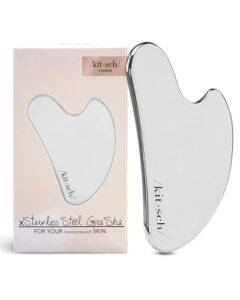This Site Is A Participant In The Amazon Services LLC Associates Program. We may earn money or products from Amazon or the companies mentioned in this post.
When it comes to acids, there are two that stand out for their benefits to the skin: glycolic acid and hyaluronic acid. Both have unique properties that make them ideal for use in skincare products. Here’s a look at the differences between these two acids and how they can benefit your skin.
Glycolic acid is an alpha hydroxy acid (AHA) that is derived from sugar cane. It is the smallest molecule of all the AHAs, which makes it able to penetrate the skin more deeply than other AHAs. Glycolic acid exfoliates the top layer of dead skin cells, revealing brighter, smoother skin underneath.
It also stimulates collagen production and helps to fade pigmentation.
Hyaluronic acid is a naturally occurring substance in the body that holds 1000 times its weight in water. It plumps up the skin, giving it a hydrated and youthful appearance.
Hyaluronic acid also helps to reduce inflammation and has been shown to be effective in treating acne scars.
Glycolic acid and hyaluronic acid are two very popular skincare ingredients. Both acids have their own unique benefits, so it can be hard to decide which one is right for your skin. Here’s a breakdown of each acid to help you make the best decision for your skincare routine.
Glycolic acid is an alpha hydroxy acid (AHA) that is derived from sugar cane. Glycolic acid is the smallest molecule in the AHA family, so it penetrates the skin more deeply than other AHAs. This makes glycolic acid an excellent choice for treating wrinkles, fine lines, and acne scars.
Glycolic acid also helps to improve the overall texture of the skin by increasing cell turnover and reducing inflammation.
Hyaluronic acid is a naturally-occurring substance that holds 1000 times its weight in water. This makes hyaluronic acid an excellent moisturizer for all skin types, even those with oily skin.
In addition to its hydrating properties, hyaluronic acid also helps to reduce inflammation and promote wound healing. It can also be used as a filler to plump up wrinkles and fine lines.
So, which one should you use?
If you’re looking for something to help with wrinkles, fine lines, or acne scars, glycolic acid is a great choice. If you’re mostly concerned with hydration, then hyaluronicacid would be a better option. However, both acids offer great benefits for the skin, so using them together could give you the best results!
How to Layer Glycolic Acid and Hyaluronic Acid
Can I Use Hyaluronic Acid And Glycolic Acid Together?
If you’re wondering whether you can use hyaluronic acid and glycolic acid together, the answer is yes! These two powerful ingredients can actually complement each other quite well.
Glycolic acid is an alpha hydroxy acid (AHA) that’s derived from sugar cane.
It’s known for its ability to deeply exfoliate the skin, which can help improve the appearance of wrinkles, fine lines, uneven skin texture, and more. Glycolic acid also helps to boost collagen production, making it a great anti-aging ingredient.
Hyaluronic acid, on the other hand, is a humectant that attracts and binds water to the skin.
This makes it an excellent hydrating ingredient that can help plump up the skin and reduce the appearance of dryness and fine lines.
When used together, these two ingredients can work synergistically to give you beautiful, healthy-looking skin.
Should I Use Hyaluronic Acid Or Glycolic Acid First?
If you’re wondering whether to use hyaluronic acid or glycolic acid first in your skin care routine, it really depends on your skin type and what specific concerns you’re trying to target.
Both acids are great for boosting hydration and helping to improve the overall appearance of the skin, but they each have slightly different benefits.
Glycolic acid is a more powerful exfoliating agent than hyaluronic acid, so it’s better at addressing concerns like Dullness, uneven texture, and clogged pores.
If you have dry or sensitive skin, however, glycolic acid can be too harsh and irritate the skin. In this case, it’s better to start with hyaluronic acid to help boost hydration before adding in a Glycolic Acid toner or serum later on.
Hyaluronic acid is also a good choice for those with acne-prone skin as it can help to reduce inflammation and redness.
And since it’s a humectant (meaning it helps attract and retain moisture), it’s great for keeping the skin plump and hydrated.

Credit: www.oceanclinic.net
Glycolic Acid Vs Hyaluronic Acid Vs Retinol
Glycolic Acid Vs Hyaluronic Acid Vs Retinol
When it comes to skin care, there are a lot of different products on the market that claim to be able to improve your skin’s appearance. However, with so many options available, it can be hard to know which one is right for you.
If you’re looking for a way to reduce wrinkles, fine lines, and other signs of aging, you may be wondering if glycolic acid, hyaluronic acid, or retinol is the best option.
Glycolic acid is an alpha hydroxy acid that is derived from sugar cane. It works by breaking down the bonds between dead skin cells, which allows them to be shed more easily.
This process can help to improve the overall appearance of your skin by making it appear smoother and brighter. Glycolic acid is often used in anti-aging products because it can help to reduce the appearance of wrinkles and fine lines over time.
Hyaluronic acid is a substance that occurs naturally in our bodies.
It helps keep our skin hydrated by binding water molecules together. When our skin doesn’t have enough hyaluronic acid, it can become dry and wrinkled. topically applying products that contain hyaluronic acid can help replenish these levels and improve the overall appearance of our skin.
Retinol is a form of vitamin A that has been shown to boost collagen production and increase cell turnover rates. This can help reduce the appearance of wrinkles and fine lines while also improving the texture of your skin over time. Retinol is typically found in higher-end anti-aging products due to its efficacy but may not be suitable for those with sensitive skin types.
Glycolic Acid And Hyaluronic Acid Together
If you’re looking for a powerful skincare duo, look no further than glycolic acid and hyaluronic acid. Glycolic acid is an alpha hydroxy acid that gently exfoliates the skin, while hyaluronic acid is a humectant that draws moisture to the skin. Together, these two acids can help improve the appearance of fine lines, wrinkles, and uneven skin tone.
Glycolic acid works by dissolving the bonds that hold dead skin cells together. This allows for gentle exfoliation of the top layer of skin, revealing brighter, more youthful-looking skin underneath. Glycolic acid also helps to stimulate collagen production, which can help reduce the appearance of fine lines and wrinkles over time.
Hyaluronic acid is a natural substance that occurs naturally in our bodies. It’s known for its ability to attract and hold water molecules, which makes it an excellent moisturizer for the skin. When used together, glycolic acid and hyaluronicacid can help improve the appearance of dryness, dullness, and aging skin.
Glycolic Acid Or Hyaluronic Acid First
Glycolic acid and hyaluronic acid are both great ingredients for your skin. But which one should you use first?
Glycolic acid is an alpha hydroxy acid (AHA) that exfoliates the top layer of skin.
This can help to improve the appearance of fine lines, wrinkles, and uneven skin tone.
Hyaluronic acid is a moisture-binding ingredient that helps to keep skin hydrated. It can also help to reduce the appearance of fine lines and wrinkles.
So, which one should you use first? Glycolic acid or hyaluronic acid?
The answer depends on your goals.
If you want to improve the appearance of fine lines and wrinkles, glycolic acid is a good choice. If you’re more concerned with keeping your skin hydrated, hyaluronic acid is a better option.
Conclusion
Glycolic acid and hyaluronic acid are two of the most popular acids used in skincare. They both have unique benefits that can help improve the appearance of your skin.
Glycolic acid is an alpha hydroxy acid (AHA) that is derived from sugar cane.
It’s commonly used in skincare products because it can help to exfoliate the skin, unclog pores, and reduce the appearance of fine lines and wrinkles. Glycolic acid can be found in cleansers, toners, serums, and moisturizers.
Hyaluronic acid is a type of carbohydrate that is naturally produced by our bodies.
It’s often used as a topical treatment to help hydrate and plump the skin. Hyaluronic acid can be found in serums, gels, creams, and masks.
Both glycolic acid and hyaluronic acid are effective ingredients that can improve the health and appearance of your skin.
When choosing a product containing either ingredient, it’s important to select one that’s suitable for your skin type and needs.

Amelia Varley is a professional beauty blogger and freelance writer with a passion for all things skincare, makeup, and holistic wellness. With years of experience in the beauty industry, Amelia shares expert tips, product reviews, and innovative beauty routines with her readers. Her writing is driven by a desire to empower people to look and feel their best through mindful beauty practices. When she’s not writing, Amelia enjoys experimenting with the latest beauty trends and exploring the connection between self-care and confidence.





